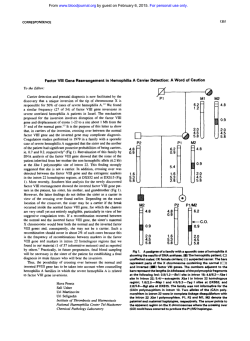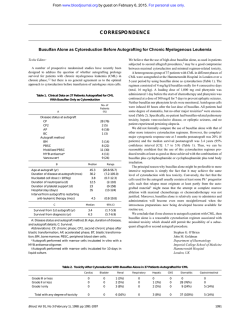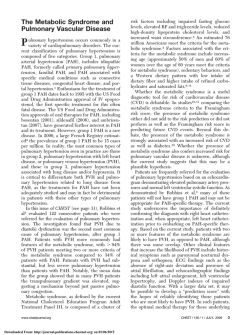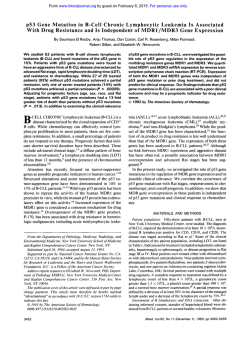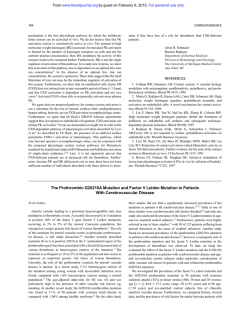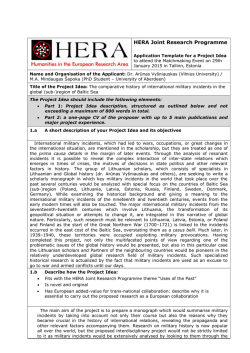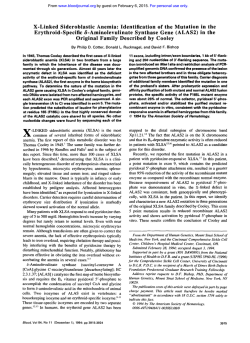
A molecular survey of phenylketonuria in Lithuania: spectrum
J. Kasnauskienë, L. Cimbalistienë, V. Kuèinskas A molecular survey of phenylketonuria in Lithuania: spectrum, frequency and phenotypical manifestation of 2)0 gene mutations J. Kasnauskienë, L. Cimbalistienë, V. Kuèinskas Department of Human and Medical Genetics, Vilnius University, Santariðkiø 2, LT-2021 Vilnius, Lithuania Phenylketonuria (PKU), a relatively common inherited disorder of amino acid metabolism, is caused by a variety of mutations in the phenylalanine hydroxylase (PAH) gene. We report the spectrum of the PAH gene mutations in individuals with PKU residing in Lithuania. A total of 184 independent PKU chromosomes (92 unrelated patients with PKU) were investigated. All 13 exons of the PAH gene of all PKU probands were scanned for DNA alterations by denaturing gradient gel electrophoresis (DGGE) with subsequent identification of mutations by sequencing relevant exons. Twenty-one different PAH gene mutations were identified in Lithuania, resulting in an overall PKU mutation detection rate of 95.1%. Out of them, 16 were novel for Lithuania (i.e. identified in the course of this study). The most frequent PAH gene mutations in PKU patients from Lithuania were R408W (73.4% of PKU chromosomes) and R1580 (7.1% of PKU chromosomes). Relative frequencies of other mutations were less than 2%. Fourteen mutations were represented by single cases with a relative frequency of 0.5%. Such data point to a significant homogeneity of the Lithuanian population. Key words: phenylketonuria, PKU, PAH gene mutations INTRODUCTION Phenylketonuria (PKU) is the commonest inborn error of amino acid metabolism in Europeans and one of the commonest autosomal recessive diseases worldwide. It is caused by mutations in the phenylalanine hydroxylase (PAH) gene. Mutations are responsible for a deficiency of the hepatic enzyme, phenylalanine hydroxylase (PheOH; EC 1.14.16.1). The spectrum of PheOH deficiency ranges from a severe hyperphenylalaninaemia (classical PKU), leading to a profound mental retardation unless the dietary intake of phenylalanine (Phe) is restricted [1], to mild hyperphenylalaninaemia (MHP) which does not require treatment. Since the identification of the PAH gene in 1986 [2], almost 400 different mutations and sequence polymorphisms have been identified and listed in the PAH mutation databalse [3]. Their phenotypic manifestation differs in residual enzyme activity, and the PAH genotype has recently been shown to be a good predictor of biochemical phenotype in the majority of patients [4]. Correspondence to Prof. V. Kuèinskas. E-mail: [email protected] ISSN 13920146. B i o l o g i j a . 2002. Nr. 3 $ Over the last decade, comprehensive mutation data have become available for most European countries. There are marked differences in the spectrum of mutations and in the degree of heterogeneity among the regions. Southern European populations are heterogeneous, with the most common mutation IVS1011g>a accounting for 1020% of PKU chromosomes [5, 6], while northern and northern-western European populations have other relatively frequent mutations, such as IVS12+1g>a (37% of PKU chromosomes in Denmark [7]) or R408W (42% of PKU chromosomes in Ireland [8]). In Eastern Europe there is one predominant mutation, R408W, with a relative frequency 7080% in the Baltic states [912]. The frequency of five PAH mutations (R408W, R158Q, R261Q, G272X and IVS10nt-11g>a) in Lithuania has already been reported [911]. Here we expand the analysis through the study of 92 unrelated PKU families from Lithuania, using the approach based on PCR amplification of the PAH gene exons, mutation scanning by denaturing gradient gel electrophoresis (DGGE), and mutation identification by direct automated DNA sequencing. A molecular survey of phenylketonuria in Lithuania: spectrum, frequency and phenotypical manifestation of PAH ... SUBJECTS, MATERIALS AND METHODS Patients with PheOH-deficient hyperphenylalaninaemia from 92 independent families (88 probands with PKU and 4 probands with MHP) living in Lithuania were investigated. Samples were collected at the Human Genetics Centre of Vilnius University Hospital. Paternal samples were available from 63 families. The nationality and place of birth of both sets of grandparents were recorded. Genomic DNA was extracted from blood leukocytes of the patients and both parents (when available). Restriction enzyme digestion based testing for the most common R408W mutation was performed [14]. To identify other mutations, the whole PAH gene (all 13 exons) of each patient was scanned by standard [13] or multiplex [14] DGGE (DGGE C.B.S. Scientific Company, Inc., USA). The exons showing variant electrophoretic patterns were sequenced by an ABI PRISMTM 310 automated gene analyzer and Big Dye Terminator Sequencing protocol (Perkin Elmer Applied Biosystems, USA). Maternal and paternal inheritance of PAH gene mutations was determined in all families where paternal DNA was available. RESULTS AND DISCUSSION Ninety-two unrelated patients with PKU (i.e. 184 unrelated PKU chromosomes) were available for molecular genetic testing in this study. Standard and/or multiplex DGGE was applied to screen for PAH gene mutations in 36 PKU probands with the PAH locus genotype Mut/? or ?/?; 20 DNA samples from the probands with the genotype R408W/ R408W were screened for the presence of other DNA polymorphisms in the PAH gene. In the case of a DGGE pattern specific for the genotype, Mut/Norm, Mut/Mut or Mut1/Mut2 corresponding DNA fragments were sequenced to identify the mutation. Twenty-one different PAH gene mutations were identified in Lithuania (Table 1). Thus, im- plementation of multiplex DGGE and direct automated DNA sequencing increased the overall mutation detection rate to 95.1% versus 79.2% previously achieved by direct testing for a set of PAH gene mutations by PCR amplification of a definite PAH gene exon with subsequent digestion with a relevant restriction enzyme. It should be pointed out that the latter relatively high value was obtained due to the particular prevalence of the R408W mutation in Lithuania (see below). All 21 PAH gene mutations identified in Lithuania appeared to have already been registered in the PAH gene mutations database [3]. Out of them, 16 were novel for Lithuania (i.e. identified in the course of this study). The most frequent PAH gene mutations in PKU patients from Lithuania were R408W (73.4% of PKU chromosomes) and R158Q (7.1% of PKU chromosomes). Other mutations were rare and showed a relative frequency less than 2%. Of them, 14 mutations were represented by single cases with a relative frequency of 0.5%. Such data point to a significant homogeneity of the Lithuanian population. No disease-causing PAH gene mutation has been identified yet on nine PKU chromosomes (4.9%) using the PCR → DGGE → DNAsequencing-based approach applied in the current Table 1. PAH gene mutations identified in 92 unrelated PKU patients residing in Lithuania Exon/intron Trivial name Exon 1 Exon 2 Number of independent Systematic name chromosomes Mutation L15S16fsdelCTb DelF39b F55fsb Intron 2 IVS213t>gb Exon 3 R111Xb Exon 5 R158Qa Exon 6 R176Xb E221D222fsdelAGb Exon 7 V245Ab R261Xb R261Qa G272Xa E280Kb P281Lb Exon 9 1306Vb L311Pb Intron 10 IVS10nt-1g>ab IVS10nt-11g>aa Exon 12 A403Vb R408Wa Y414Cb Unidentified mutationc c.4748delCT c.115117delTTC c.165delT c.16913t>g c.311C>T c.472G>A c.526C>T c.663664delAG c.734T>C c.781T>C c.782G>A c.814G>T c.838G>A c.842C>T c.916A>G c.932C>T c.1065+1g>a c.106611g>a c.1208C>T c.1222C>T c.1241A>G 1 1 1 2 1 13 1 1 1 1 1 3 2 2 1 1 1 1 4 135 1 9 Frequency (%) 0.5 0.5 0.5 1.1 0.5 7.1 0.5 0.5 0.5 0.5 0.5 1.6 1.1 1.1 0.5 0.5 0.5 0.5 2.2 73.4 0.5 4.9 PAH gene mutations identified in Lithuania before and during this study. PAH gene mutations identified in Lithuania during this study. c Mutations unidentifiable using PCR → DGGE → DNA-sequencing-based approach. a b $ J. Kasnauskienë, L. Cimbalistienë, V. Kuèinskas ed in the article of P. Guldberg et al. [15]). In the case of seveClinical re PKU with one known severe phenotype mutation (P281L/?), the other unidentified mutation was most Severe PKU likely severe. In all cases with Severe PKU Severe PKU the genotype ?/? phenotypic feaSevere PKU tures of the patients from LiSevere PKU thuania were typical of severe Severe PKU PKU with good response to the Severe PKU dietary treatment (low Phe Severe PKU diet). Therefore BH4 deficiency Severe PKU was excluded, and mutations on Severe PKU both PKU chromosomes were Severe PKU most likely severe in these caSevere PKU ses. The varying severity of hySevere PKU perphenylalaninemia in the caSevere PKU ses with the genotype R408W/? Severe PKU carrying a severe mutation Severe PKU R408W implies the unidentified Severe PKU mutations to be heterogeneous. Moderate PKU The homogeneity of PKU in Moderate PKU1 Lithuania and other Baltic states Severe PKU3 is reflected by a particular preMild PKU valence of the R408W mutation MHP and a reduced spectrum of other Mild PKU3 PAH gene mutations if compared MHP1 to a number of European popuUnclassified lations (Table 3). This mutation Severe PKU is still the most common one in individuals with PKU in Germany [4], while in Italy it is classified as rare [6]. Thus, a north to south frequency gradient is characteristic of the R408W mutation of the PAH gene in Europe. As regards the spectrum of other PAH gene mutations in European PKU populations, a combination of the particular prevalence of the R408W mutation and a Table 2. Genotype and phenotype correlation in PKU patients No. of cases Phenotype frequency (%) 50 10 3 1 2 1 1 1 1 1 1 1 1 1 1 1 1 1 4 54.3 10.9 3.3 1.1 2.2 1.1 1.1 1.1 1.1 1.1 1.1 1.1 1.1 1.1 1.1 1.1 1.1 1.1 4.2 20. R408W/Y414C 21. R408W/1306V 22. R408W/A403V 1 1 4 1.1 1.1 4.3 23. R111X/V245A 24. ?/? Total 1 2 92 1.1 2.2 100 PAH locus genotype 1. R408W/R408W 2. R408W/158Q 3. R408W/G272X 4. R408W/IVS2nt-13t>g 5. R408W/E280K 6. delF39/IVS10nt-11g>a 7. R408W/L311P 8. R408W/P281L 9. R408W/R176X 10. R408W/L15S16fsdelCT 11. R408W/R261X 12. R408W/R261Q 13. R408W/IVS10nt-1g>a 14. R408W/E221D222delAG 15. R408W/F55fs 16. P281L/? 17. R158Q/R158Q 18. R158Q/IVS2nt-13t>g 19. R408W/? investigation (i.e. DGGE patterns did not show any electrophoretic pattern characteristic of DNA alterations). This approach does not allow identification of large deletions spanning the whole exons or mutations in large introns. The mutation detection rate (95.1%) and methods for detection of PAH gene mutations are similar to the rate and methods Table 3. Features of PKU mutations in some of other relevant molecular diagnostic laborapulations tories. Data on the PAH locus genotypes identified Number of Frequency PKU different PAH of the in Lithuania are summarized in Table 2. The population gene mutations R408W most frequent genotype in unrelated PKU paidentified mutation (%) tients was R408W/R408W (54.3%); 38% of paa 6 84 Estonia tients harboured the R408W mutation with a 10 77 Latviab different mutation on the other PKU chromo21 73.4 Lithuaniac some. d 91 22 Germany The correlation of the PAH locus genotype e Italy 24 1 and the clinical phenotype estimated in PKU a [12] patients from Lithuania corresponds to that obb [17] served by other investigators in a number of c Present study European populations, supporting the establisd [4] hed assigment of PAH mutations to the metae [6] bolic phenotypes (according to the list present$ European poNumber of PKU chromosomes investigated 68 96 184 546 289 A molecular survey of phenylketonuria in Lithuania: spectrum, frequency and phenotypical manifestation of PAH ... relatively small number of indivuals with PKU available for investigation explain a relatively low variety of mutations identified in Lithuania, Latvia and Estonia. ACKNOWLEDGEMENTS The research was supported by European Commission INCO-COPERNICUS programme; contract grant number: ERB IC 15-CT98-0337. References 1. Scriver CR, Beaudet AL, Sly WS, Valle D (eds.). The metabolic and molecular bases of inherited diseases. New York, 1996: 101577. 2. DiLella AG, Kwok SCM, Ledley FD, Marvit J, Woo SLC. Biochemestry 1986; 25: 74349. 3. PAHdb; http://www.mcgill.ca/pahdb. 4. Zschocke J, Hoffmann GF. Hum Genet 1999; 104: 3908. 5. Guldberg P, Romano V, Ceratto N, Bosco P, Ciuna M, Indelicato A, Mollica F, Meli O, Giovannini M, Riva E, Biasucci G, Henricsen KP, Güttler F. Hum Mol Genet 1993; 2: 17037. 6. Giannattasio S, Dianzani I, Lattanzio P, Spoda M. Hum Hered 2001; 52: 1549. 7. Gulberg P, Henriksen KF, Guttler F. Genomics 1993; 17: 1416. 8. ONeill CA, Eisensmith RC, Croke DT, Naughton ER, Cahalane SF, Woo SLC. Acta Paediatr Suppl 1994; 407: 434. 9. Kalaydjieva L, Dworniczak B, Kucinskas V, Yurgeliavicius V, Kunert E, Horst J. Hum Genet 1991; 86: 411413. 10. Giannattasio S, Jurgelevièius V, Lattanzio P, Cimbalistienë L, Marra E, Kuèinskas V. Hum Hered 1997; 47(3): 15560. 11. Kuèinskas V, Jurgelevièius V, Cimbalistienë L, Holmgren G. Hum Hered 1994; 44(2): 1103. 12. Lilleväli H, Ounap K, Metspalu A. Eur J Hum Genet 1996; 4: 296300. 13. Gulberg P, Güttler F. Nucleic Acids Res 1994; 22: 8801. 14. Steponavièiûtë D, Kuèinskas V. Biologija 2002; 36 (this issue) 15. Zschocke J, Mallory JP, Eiken HG, Nevin NC. Hum Genet 1997; 100: 18994. 16. Gulberg P, Rey F, Zschocke J. Am J Hum Genet 1998; 63: 719. 17. Pronina N, Lugovska R, Vevere P, Kornejeva A. Eur J Hum Genet 2002; 10: P0780. J. Kasnauskienë, L. Cimbalistienë, V. Kuèinskas MOLEKULINË FENILKETONURIJOS APÞVALGA LIETUVOJE: 2)0 GENO MUTACIJØ SPEKTRO IR DAÞNIO NUSTATYMAS IR JØ FENOTIPINIS PASIREIÐKIMAS Santrauka Fenilketonurija (FKU) yra daþniausias aminorûgðèiø apykaitos sutrikimas, nulemtas mutacijø fenilalaninhidroksilazës (PAH) gene. Mes pateikiame serganèiøjø FKU Lietuvoje PAH geno mutacijø spektrà. Tyrimo metu analizuotos 184 FKU chromosomes (92 negiminingø asmenø, serganèiø FKU). Tiriamøjø DNR PAH geno visi 13 egzonø buvo tiriami denatûruojanèio gradientinio gelio elektroforezës (DGGE) metodu ir nustatyta tiesioginë nukleotidø seka tø egzonø, kuriuose rasta pakitimø. Iðaiðkinta 21 skirtinga mutacija, 16 ið jø Lietuvoje nustatytos pirmà kartà. Mutacijos identifikuotos 95,1% chromosomø: 73,4% sudaro R408W, 7,1% R158Q mutacija. Kitos mutacijos retos jø daþnis svyruoja nuo 0,5 iki 2%. 14 mutacijø nustatyta tik vienoje chromosomoje (0,5%). PAH mutacijø ávairovës atþvilgiu lietuviø populiacija yra sàlyginai homogeniðka. $!
© Copyright 2025
